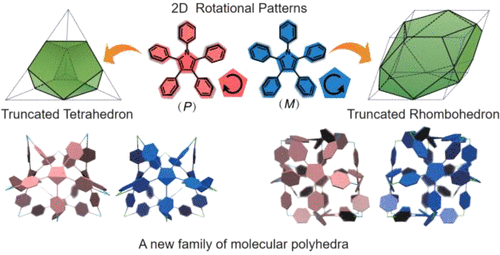
2020

04 Nov 2020, SCIENTIA SINICA Chimica
Zhi-Chao Lei , Xinchang Wang , Hang Qu , Cen Zhou , Zhihao Li , Liulin Yang , Xiaoyu Cao , Zhong-Qun Tian
Molecular assembly plays a critical role in constructing the physical world beyond molecules. Living organism shows the highest level of molecular assembly, inside which complex subunits assemble into functional assemblies through complex intermolecular interactions. Self-assembly is the dominant paradigm in the research of artificial molecular assembly, whereas most molecular assemblies in living organism are multi-pathway, multi-step, and hierarchical, thus requiring the assistance and guidance of other molecules. Among these assisting methods, catassembly uses catassemblers to modulate the kinetics and pathways of the assembly processes, exhibiting high efficiency and selectivity. In living organisms, catassemblers such as molecular chaperones, histone chaperones and allosteric factors are critical to protein folding, chromatin remodeling, and regulation of enzyme activities, respectively. In this review, we analyzed and then summarized various catassembly cases in living organisms, and envisioned that catassembly will be more important in more complex molecular assemblies. These investigations may provide a new perspective for the development of catassembly in artificial and living systems, and further improve the complexity, controllability and function of molecular assembly to a higher level.

16 Sep 2020, Nature Communications
Shiyan Chen, Longzhu Liu, Xiang Gao, Yuhui Hua, Lixia Peng, Ying Zhang, Liulin Yang, Yuanzhi Tan, Feng He*, Haiping Xia*
The metal-carbon triple bonds and carbon-carbon triple bonds are both highly unsaturated bonds. As a result, their reactions tend to afford cycloaddition intermediates or products. Herein, we report a reaction of M≡C and C≡C bonds that affords acyclic addition products. These newly discovered reactions are highly efficient, regio- and stereospecific, with good functional group tolerance, and are robust under air at room temperature. The isotope labeling NMR experiments and theoretical calculations reveal the reaction mechanism. Employing these reactions, functionalized dπ-pπ conjugated systems can be easily constructed and modified. The resulting dπ-pπ conjugated systems were found to be good electron transport layer materials in organic solar cells, with power conversion efficiency up to 16.28% based on the PM6: Y6 non-fullerene system. This work provides a facile, efficient methodology for the preparation of dπ-pπ conjugated systems for use in functional materials.

04 Sep 2020, Journal of American Chemistry Society
Hang Qu, Zheyu Huang, Xue Dong, Xinchang Wang, Xiao Tang, Zhihao Li, Wenbin Gao, Haoliang Liu, Ruishan Huang, Zujin Zhao, Hui Zhang, Liulin Yang*, Zhongqun Tian, and Xiaoyu Cao*
Discovering novel families of molecular polyhedra through graph theory has attracted increasing interest. Nevertheless, the design principles of molecular polyhedra based on graph theory remain elusive, especially for those containing five-node units. Herein, we construct a series of chiral truncated face-rotating polyhedra (T-FRP) from pentagonal pentaphenylpyrrole (PPP) derivatives and chiral diamines. Graph theory is used to elucidate the geometry of these novel T-FRP, which represent a new family of molecular polyhedra. The phenyl flipping of PPP faces in these T-FRP is significantly restricted, thus making T-FRP chiral and strongly emissive in solution. In addition, T-FRP also generate circularly polarized luminescence. This study provides new insights into the rational design of novel molecular polyhedra through graph theory.
21 Feb 2020, Pattern Recognition
Xiaoyan Cao, Shihui Guo, Juncong Lin, Wenshu Zhang, Minghong Liao
Tracking movement of insects in a social group (such as ants) is challenging, because the individuals are not only similar in appearance but also likely to perform intensive body contact and sudden movement adjustment (start/stop, direction changes). To address this challenge, we introduce an online multi-object tracking framework that combines both the motion and appearance information of ants. We obtain the appearance descriptors by using the ResNet model for offline training on a small (N=50) sample dataset. For online association, a cosine similarity metric computes the matching degree between historical appearance sequences of the trajectory and the current detection. We validate our method in both indoor (lab setup) and outdoor video sequences. The results show that our model obtains 99.3% ± 0.5% MOTA and 91.9% ± 2.1% MOTP across 24,050 testing samples in five indoor sequences, with real-time tracking performance. In an outdoor sequence, we achieve 99.3% MOTA and 92.9% MOTP across 22,041 testing samples. The datasets and code are made publicly available for future research in relevant domains.

20 Feb 2020, ACS Macro Letters
Y. Chen†, L. L. Yang†, W. Zheng, P. F. Ouyang, H. Zhang, Y. H. Ruan, W. G. Weng, X. M. He, H. P. Xia
It is appealing to develop dynamic polymer systems with multifunctionl properties. Herein, we report a polyurethane elastomer with a dynamic covalent polymer network containing a radically exchangeable 2-arylindane-l,3-dione dimer as thermally sensitive and reversible cross-links. In addition, the carbolong complex, an excellent photothermal agent, is incorporated into the dynamic network backbone. With the irradiation of NIR light, the carbolong complex rapidly generates thermal energy, which subsequently triggers the cleavage of the dynamic covalent bond to generate radicals and activate the polyurethane network. In proof-of-concept experiments, we demonstrate that the utility of a combination of radically exchangeable covalent bond and carbolong moiety brings multiple functional characteristics to the polymer network with a capability of spatiotemporal control, including thermochromism, photochromism, rewritability, malleability, and self-healing. This study holds potentials for exploring more tunable dynamics and improved material properties.
Complex Assembly System © Copyright 2020




